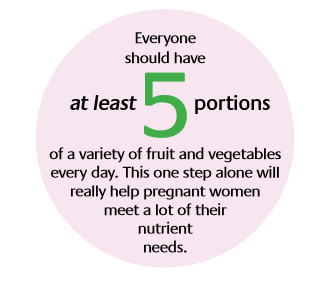Start the day with an egg; Eggs are an important source of
nutrients, and having an egg for breakfast several mornings each week will
contribute to intakes of vitamin A, vitamin D, thiamin, riboflavin, vitamin
B₁₂, iron, calcium, zinc, and choline, many of which are particularly important
in pregnancy.
Eggs are cheap, very easy to cook, and very versatile. Examples, breakfasts, snacks, and meals that include eggs. We use free-range eggs in our meal and snack ideas. You can eat well and ethically on a budget.
There is a lot of advice available for pregnant women to
support them to eat well in pregnancy, and other useful and expert resources
are extensively outlined in this blog. Below are some specific practical
tips that may be useful when supporting women during their pregnancy.
Tips for meal planning in pregnancy
Make time for breakfast
A small snack in the morning may help with nausea in early
pregnancy. If breakfast is missed, it is more likely that people will snack
mid-morning on high-fat, high-salt, and high-sugar foods and miss out on some
important nutrients like B vitamins, fiber, iron, and zinc that are found in
cereals and breads. Most breakfast cereals are a good source of energy, fiber
and other nutrients, and low-sugar, low-salt cereals like weet bisks, puffed
wheat, crisped rice, cornflakes, and malted wheat are good breakfast choices and
can also be snacks at other times of the day.
It is a good idea to have a glass of 100% fruit juice with
breakfast, as fruit juice is a good source of vitamin C, and vitamin C may help
the body to absorb iron from cereal foods.
Breakfast does not have to include traditional breakfast
foods, however. Practical examples of nutritious breakfasts or other meals and snacks
that could be eaten in the morning can be found on HEALTHY MEALS.
Eat more vegetables
Almost everyone would benefit from eating more vegetables
every day. There is excellent evidence that eating more vegetables is
associated with better health throughout people’s lives. And vegetables taste
good and are cheap, versatile, and colorful, so it’s very unlikely someone
won’t find a vegetable they like.
 |
Everyone should aim to have at least three
different types of vegetables or salads every day at portions of 80 gm or more. A
wide variety of fresh, dried, canned, and frozen vegetables can be included in
the diet. It is fine to eat more, and in lots of countries, they now say that
half of all your main meals should be vegetables.
People who say they don’t like vegetables may be more
willing to try:
- Sweetcorn or baby corncobs
- Raw carrot sticks, slices of red and yellow peppers, or cherry tomatoes
- Tomato sauce on pasta
- ‘bubble and squeak’ (green cabbage and mashed potato mixed together)
- stir-fry vegetables
- Vegetable soup
- Vegetable curry
- grated carrot as a salad.
Eat more fruit
Everyone should have at least two different types of fruit a
day. One of these can be a glass of 100% fruit juice and the other can be a
piece of fresh fruit or a small portion of dried fruit or some canned or frozen
fruit.
People who say they don’t like fruit may be more willing to
try:
- Canned or fresh pineapple, peaches or fruit salad in fruit juice
- Fruit smoothies (fresh or canned fruit in juice liquidized together with other fruit, natural low-fat yogurt or fruit juice), or fresh fruit milkshakes made with skimmed milk and fruit
- Raisins, or other dried fruit such as dates, apricots, pear or mango
- Banana with ice cream or custard
- Fresh fruit jellies or home-made lollies
- Fruit kebabs
- Frozen bananas.
Eating more locally and organically grown fruits and vegetables
We are able to grow a wide range of fruits and vegetables in most parts of the world and it is better for the environment and the
economy, if we all try and eat foods that do not have to travel long distances.
Also, it is better for the environment if fruits and vegetables are grown
without the need for artificial heat, or for lots of added chemicals.
Organic fruits and vegetables do not contain more nutrients
than conventionally grown ones, but farmers who grow food organically make an important contribution to protecting wildlife and keeping the land and soil
healthy.
Eat more potatoes
Potatoes are an excellent source of nutrients and fiber, as
well as being a starchy, ‘energy-giving’ food. Potatoes grow well in most
parts of the world and can often be sourced locally. Potatoes are really
versatile, are very good value for money, and are easy to cook. Jacket potatoes
with fillings such as mashed tuna fish or baked beans or low-fat soft cheese,
and served with a salad or hot vegetable, can be a very quick, easy, and
nutritious meal.
Ideas for fillings for the baked potato
- Baked beans
- Baked beans with a few drops of chili sauce
- Cheddar cheese and chopped cherry tomatoes
- Chicken and broccoli
- Chili con carne
- Cottage cheese with chopped pineapple
- Cottage cheese with onion and chives
- Grated cheese and tomato Ham and chopped pineapple Houmous
- Low-fat soft cheese
- Mashed tuna
- Mashed tuna, grated carrot, and chopped cherry tomatoes
- Mozzarella, chopped tomato, and basil
- Plain yogurt mixed with coriander, chopped cucumber and spring onion
- Roasted peppers
- Scrambled egg with chopped tomatoes and red pepper
- Tomato salsa
- Tuna and sweetcorn mayonnaise

